by Bruce Wells | Feb 17, 2025 | Petroleum Companies
Oklahoma showman Maj. Gordon W. “Pawnee Bill” Lillie caught oil fever in 1918.
With America joining “the war to end all wars” in Europe and oil demand rising, a popular Oklahoma showman launched his own petroleum exploration and refining company.
Although not as well known as his friend Col. William F. “Buffalo Bill” Cody of Wyoming, Maj. Gordon William “Pawnee Bill” Lillie was “a showman, a teacher, and friend of the Indian,” according to his biographer.

Pawnee Bill and Buffalo Bill combined their shows from 1908 to 1913 as “Buffalo Bill’s Wild West and Pawnee Bill’s Great Far East.”
Maj. Lillie was admired for being a “colonizer in Oklahoma and builder of his state,” noted Stillwater journalist Glenn Shirley in his 1958 book Pawnee Bill: A Biography of Major Gordon W. Lillie.
The two entertainers joined their shows in 1908 to form “Buffalo Bill’s Wild West and Pawnee Bill’s Great Far East,” promoted as “a glorious cavalcade of dazzling brilliancy,” noted Shirley, adding that the combined shows offered, “an almost endless procession of delightful sight and sensations.”
But times were changing as public taste turned to a new form of entertainment, motion picture shows. By 1913, the two showmen’s partnership was over and their western cavalcade foreclosed. Lillie turned to other ventures — real estate, banking, ranching, and like his former partner Cody, the petroleum industry.

Oklahoma oilfield discoveries near Yale (population of only 685 in 1913) had created a drilling boom that made it home to 20 oil companies and 14 refineries. In 1916, Petrol Refining Company added a 1,000-barrel-a-day-capacity plant in Yale, about 25 miles south of Lillie’s ranch.
The trade magazine Petroleum Age, which had covered the 1917 “Roaring Ranger” oilfield discovery in Texas, reported that for Pawnee Bill, “the lure of the oil game was too strong to overcome.”
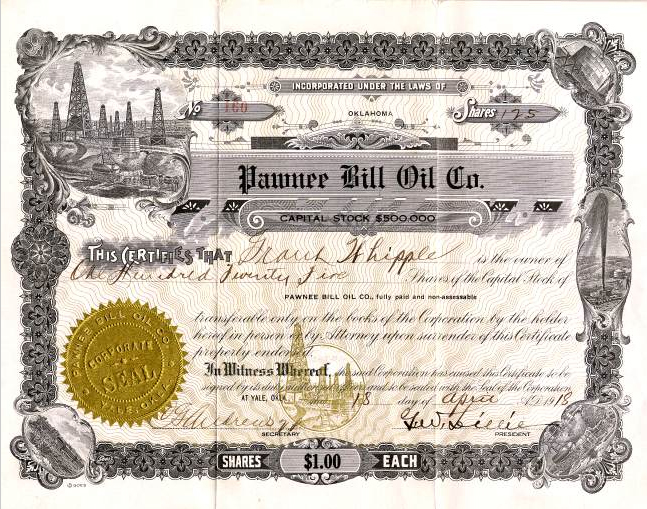
Obsolete financial stock certificates with interesting histories like Pawnee Bill Oil Company are valued by collectors.
The Oklahoma showman founded the Pawnee Bill Oil Company on February 25, 1918, and bought Petrol Refining’s new “skimming” refinery in March.
An early type of refining, skimming (or topping) removed light oils, gasoline and kerosene and left a residual oil that could also be sold as a basic fuel. To meet the growing demand for kerosene lamp fuel, early refineries built west of the Mississippi River often used the inefficient but simple process.

Maj. Gordon William “Pawnee Bill” Lillie (1860-1942).
Lillie’s company became known as Pawnee Bill Oil & Refining and contracted with the Twin State Oil Company for oil from nearby leases in Payne County.

Under headlines like “Pawnee Bill In Oil” and “Hero of Frontier Days Tries the Biggest Game in All the World,” the Petroleum Age proclaimed:
“Pawnee Bill, sole survivor of that heroic band of men who spread the romance of the frontier days over the world…who used to scout on the ragged edge of semi-savage civilization, is doing his bit to supply Uncle Sam and his allies with the stuff that enables armies to save civilization.”
Post WWI Bust
By July 30, 1919, Pawnee Bill Oil (and Refining) Company had leased 25 railroad tank cars, each with a capacity of about 8,300 gallons. But the end of “the war to end all wars” drastically reduced demand for oil and refined petroleum products. Just two years later, Oklahoma refineries were operating at about 50 percent capacity, with 39 plants shut down.
Although Lillie’s refinery was among those closed, he did not give up. In February 1921, he incorporated the Buffalo Refining Company and took over the Yale refinery’s operations. He was president and treasurer of the new company. But by June 1922, the Yale refinery was making daily runs of 700 barrels of oil, about half its skimming capacity.
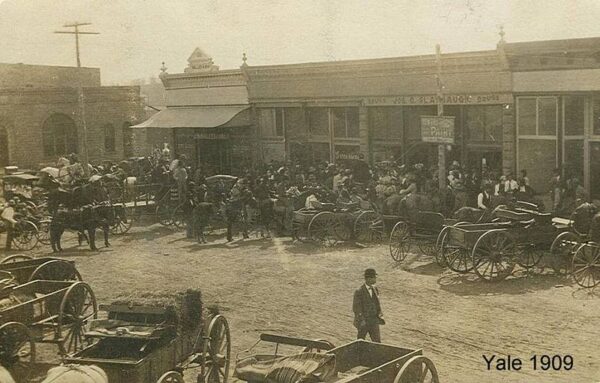
The Pawnee Bill Oil Company held its annual stockholders meetings in Yale, Oklahoma, an oil boom town about 20 miles from Pawnee Bill’s ranch.
“At the annual stockholders’ meeting held at the offices of the Pawnee Bill Oil Company in Yale, Oklahoma, in April, it was voted to declare an eight percent dividend,” reported the Wichita Daily Eagle. “The officers and directors have been highly complimented for their judicious and able handling, of the affairs of the company through the strenuous times the oil industry has passed through since the Armistice was signed.”

The Kansas newspaper added that although many Independent refineries had been sold at receivers’ sale, “the financial condition of the Pawnee Bill company is in fine shape,”
Buffalo Bill’s Shoshone Oil
What happened next has been hard to determine since financial records of the Pawnee Bill Oil Company are rare. A 1918 stock certificate signed by Lillie, valued by collectors one hundred years later, could be found selling online for about $2,500.
Maj. Gordon William “Pawnee Bill” Lillie’s friend and partner Col. William F. “Buffalo Bill” Cody also caught oil fever, forming several Wyoming oil exploration ventures, including the Shoshone Oil Company.
In 1920, yet another legend of the Old West — lawman and gambler Wyatt Earp — began his a search for oil riches on a piece of California scrubland. One century later, his Kern County lease still paid royalties; learn more in Wyatt Earp’s California Oil Wells.
_______________________
Recommended Reading: Pawnee Bill: A Biography of Major Gordon W. Lillie (1958). Your Amazon purchases benefit the American Oil & Gas Historical Society. As an Amazon Associate, AOGHS earns a commission from qualifying purchases.
(1958). Your Amazon purchases benefit the American Oil & Gas Historical Society. As an Amazon Associate, AOGHS earns a commission from qualifying purchases.
_______________________
The American Oil & Gas Historical Society (AOGHS) preserves U.S. petroleum history. Please become an AOGHS annual supporter and help maintain this energy education website and expand historical research. For more information, contact bawells@aoghs.org. Copyright © 2025 Bruce A. Wells. All rights reserved.
Citation Information – Article Title: “Pawnee Bill Oil Company.” Authors: B.A. Wells and K.L. Wells. Website Name: American Oil & Gas Historical Society. URL: https://aoghs.org/stocks/pawnee-bill-oil-company. Last Updated: February 19, 2025. Original Published Date: February 24, 2017.
by Bruce Wells | Sep 13, 2024 | Petroleum Companies
Utah company sought oil from Gilsonite deposits in 1917.
Although attempts to extract commercial amounts of oil from Utah’s abundant shale formations failed, the effort of Ute Oil Company in the Uinta Basin was far ahead of its time.
A survey party in 1861 described the Uinta Basin in eastern Utah as, “One vast contiguity of waste and measurably valueless, except for nomadic purposes, hunting grounds for Indians, and to hold the world together.”
After reading the survey report, Brigham Young, who had founded Salt Lake City in 1847, scrapped his plans to send a group of Mormon settlers to the area.

Gilsonite is a coal-like natural asphalt found in the Uintah Basin in northeastern Utah.
Young thought the arid region better suited for a Ute Indian reservation, according to historians at the Utah Humanities Council, and President Abraham Lincoln created the Uintah Reservation by executive order.

However, by the time Utah became the 45th state in 1896, the sparsely populated region bordering Colorado had begun revealing its mineral wealth, including gold, silver, lead, zinc, copper, and a soft coal-like substance.
Coalbed Methane
Coal and a coal-like hydrocarbon — Gilsonite — brought mineral exploration companies to eastern Utah soon after the turn of the century. Gilsonite, also known as North American Asphaltum, was unique to the region known for its thick shale deposits.
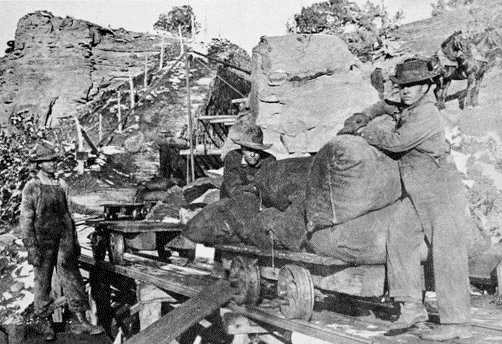
In the 1920s, companies extracted oil shale and Gilsonite from narrow mines.
By the early 20th century, aspiring entrepreneurs had arrived to exploit these new petroleum resources. Several new ventures would be among the earliest anywhere seeking to make money by squeezing oil from shale. The Uinta Basin has since become one of the largest coalbed methane producing areas in the United States.
By 2015, petroleum engineers estimated the vast desert plateau in Utah and Colorado contained between eight trillion cubic feet and 10 trillion cubic feet of gas reserves.
The Gilsonite Maneuver
“The first attempt at oil shale exploitation took place in 1917 by the Ute Oil Company,” noted the Bureau of Land Management in a 2007 technical report about oil shale and tar sands areas in Colorado, Utah and Wyoming.
Established in 1916, Ute Oil Company was created to refine petroleum from a dense shale mined north of Watson, Utah. Oil shales had proven abundant there. So had Gilsonite found in deep vertical veins. The coal-like natural asphalt had many industrial uses.

Although Ute Oil Company found Gilsonite and oil shales abundant in northeastern Utah, processing the hard shale proved too expensive as other conventional U.S. discoveries brought far lower oil prices. Color map courtesy Utah Geological Society.
Gilsonite had been vigorously promoted since 1886 by Samuel H. Gilson, its principal investigator, marketer and namesake. He formed a company to mine and market Gilsonite on a commercial scale.
Gilson, a former rider for the Pony Express between California and Missouri, believed his Gilsonite (or Uintahite) practical for use in everything from a waterproof coating for wooden pilings, as an insulation for wire cable, and as paint or a varnish. He even promoted the natural, resinous hydrocarbon as an additive for chewing gum.

Utah’s Gilsonite was selling for more than $12 a ton when in 1888, despite Bureau of Indian Affairs protests, Congress opened a 7,040 acre oil shale and Gilsonite-laden strip on the Uinta Ouray Reservation for placer mine claims.
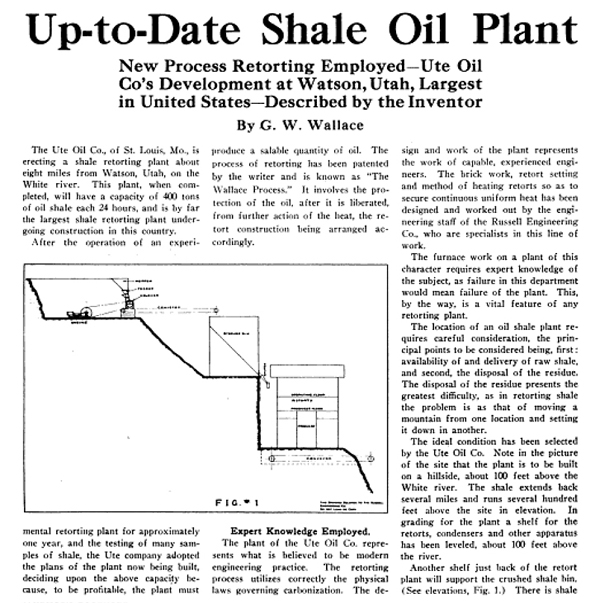
An October 1918 article in “Petroleum Age” magazine described a planned shale oil plant at Watson, Utah, that would be the largest in United States. The author is the plant’s designer, St. Louis engineer George W. Wallace, who will become superintendent of Ute Oil Company.
Placer claims could be filed for mining a fixed amount of acreage by a person or group. These claims on Indian Reservations often led to lengthy litigation. The law required production of resources in order for the claimant to be granted a legitimate right to the land. Learn more about the Placer Act in First Wyoming Oil Well.
Ute Oil Company’s interest was in oil shale’s kerogen (naturally occurring organic matter) content. Oil shales like Gilsonite can yield petroleum when sufficiently “cooked.” The distillates boil off and are captured as in other refining operations.
In eastern Utah, Ute Oil Company made a 100 acre placer claim near Watson alongside the White River, about 100 feet up a hillside where promising oil shale deposits could be cheaply mined and then refined. Other companies had the same idea.
Shale Oil Boom
The boom towns of Watson, Dragon Junction and Rainbow were spawned amidst new Gilsonite mines. A narrow gauge (and short-lived) Uintah Railroad was built specifically to link them to the Rio Grande Western Railway 63 miles away.

Oil shale production mining technologies of the 1920s were dangerous and expensive. Above is Ute Oil Company’s processing plant under construction.
By 1911, what was called the “crookedest railroad in the West” had overcome steep mountain grades and crossed 40 bridges to reach Watson and the Rainbow Gilsonite mine, above the White River. Crane Shale Oil, Utah Shale & Oil, and the Western Shale Oil Company all planned oil and gasoline reduction plants near Watson.
As the Bureau of Land Management (BLM) began tracking these early efforts to make money by extracting oil from shale, Ute Oil led the way as a petroleum industry pioneer for the oil shale boom that began in the mid-2000s.

Although the company would never complete its ambitious construction of a retorting plant for processing shale, it explored new technologies to maximize production. A 2007 BLM report explained how the company planned building its plant at Watson, today a Uintah County ghost town.
“Construction began on a tramway and processing plant ,” the report noted. “Processing was supposed to extract 90 percent of the oil contained in the pulverized oil shale to produce an average of 54 gallons of oil per ton of shale.”
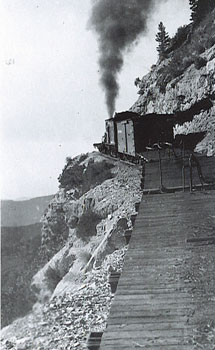
It was difficult and dangerous to get the shale out of the isolated region.
By November 1919, construction of Ute Oil’s new refinery was nearing completion near the old White River stagecoach station. The company predicted yields of 51.5 gallons of oil and 3.6 gallons of gasoline per ton of processed oil shale when the 18 retorts went onstream. The new plant had a projected capacity of 400 tons daily.
Even using modern technology, the U.S. Geological Survey has reported typical shale yields are between 15 gallons and 25 gallons of oil per ton.
In 1920, industry trade publications continued to praise oil shale developments in Utah and Colorado, but noted that high processing costs for limited production were proving hard to overcome with the day’s technology — see Central Oil Shale Refining Company, a Chicago venture that sought to profit from shale during World War I.
Hard Shale Oil Lessons
The economic possibilities of shale oil intrigued investors and the “American Gas Engineering Journal” of January 3, 1920, crowed: “Twenty-Two Billion Barrels of Oil a Possibility of the Process – Estimates of Production Cost Show Possibility of Shale Oil Competing with Gasoline at Its Lowest Previous Level.”
A Geological Survey investigator proclaimed oil shales offered “more than eight times all of the oil available from the oilfields of the United States!”

Petroleum industry trade publications recognized that Gilsonite and products made from other oil shales like Asphaltite might supplement production from U.S. oilfields, but the business model was risky. Much hinged on a small margin — limited by extraction technologies and the price of crude oil.

“A few crumbling buildings” are all that reman of Watson, Utah, where the Ute Oil Company was the first company to attempt to profit from oil shale. Quote and 1998 photo courtesy Jeremy Carter, Ghosttowns.com.
“Crude shale oil, obtained by retorting oil shale, cannot find a general market until the price of well oil is above the cost of producing shale oil,” reported the October 1921 Mining and Oil Bulletin.
“This cost has been conservatively estimated at $1.85 a barrel, for mining and retorting,” the trade publication added. “When the price of well petroleum approaches or better — exceeds this figure — the production of crude shale oil will take on renewed activity.”
Ute Oil Company had optimistically projected its cost at only $1.02 per barrel. In 1918, the year after the company formed, oil sold for about $1.98 per barrel, but in 1920, it dropped to $1.73. It would get much worse. By 1931, oil prices had dropped to only about 65 cents per barrel.
Ute Oil company’s profit margin depended a high price for oil, but surging oil supplies from traditional oil wells in Texas and other states drove down the price.

By the 1920s, many industry publications were following attempts to develop oil shales in Utah and Colorado. In addition to the “Oil and Gas News” prediction above, the “American Gas Engineering Journal” envisioned production of 22 billion barrels of oil from shale.
End of Ute Oil
In addition to the financial and technological risks that Ute Oil faced, regulatory issues added to its misery. In 1920, Congress passed the Mineral Leasing Act, updating the archaic 1872 law and requiring for the first time that the federal government receive royalty payments from successful placer claims.
An ominous 1921 “Petroleum Times” article noted work had been delayed “by a controversy with the Government over title to the land.”

The litigation among private, state, federal and Indian tribal interests would last decades. The controversy came from renewed congressional interest in rectifying injustices that had historically deprived the Uinta Basin Indians since the reservation had been formed in 1861.
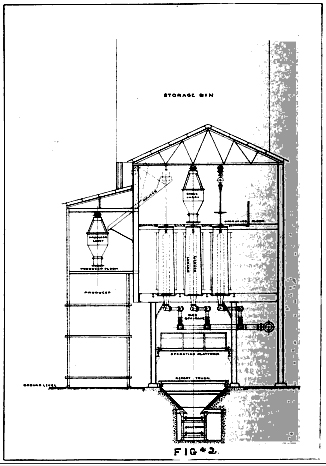
Ute Oil Company failed in 1923 before it could complete its uniquely designed retort for processing oil shale.
Although legal battles would continue, Ute Oil’s fate was sealed. Trade publications reported that the company undertook reorganization in 1923, but did not survive. The BLM would later note that “interest in oil shale production rebounded when oil prices peaked in the 1970s.”
In 1909, Earl Douglass, paleontologist for the Carnegie Museum in Pittsburgh, discovered dinosaur bones in the Utah desert. The site was soon designated the Dinosaur National Monument, and Douglass later became an eloquent spokesman for Utah’s petroleum industry.
J.L. “Mike” Dougan made the state’s first major oi discovery in 1948 after drilling unsuccessfully in Utah for more than 25 years (see First Utah Oil Wells).

In the Energy Policy Act of 2005, Congress declared U.S. oil shale and tar sands strategically important domestic energy resources that should be developed to reduce dependence on imported oil. Five years later, Utah produced more than 8.1 trillion cubic feet of natural gas valued at more than $1.7 billion.
Depending on quality and location of the resource, U.S. market price of Gilsonite in the early 2020s ranged from $600 to $1,000 a ton — compared to $10 to $12 per ton in the late 1800s.
_______________________
Recommended Reading: Utah Oil Shale: Science, Technology, and Policy Perspectives (2016); From the Ground Up: A History of Mining in Utah (2006); Your Amazon purchase benefits the American Oil & Gas Historical Society. As an Amazon Associate, AOGHS earns a commission from qualifying purchases.
(2016); From the Ground Up: A History of Mining in Utah (2006); Your Amazon purchase benefits the American Oil & Gas Historical Society. As an Amazon Associate, AOGHS earns a commission from qualifying purchases.
_______________________
The American Oil & Gas Historical Society (AOGHS) preserves U.S. petroleum history. Please become an AOGHS supporter and help maintain this website and expand historical research. For more information, contact bawells@aoghs.org. Copyright © 2024 Bruce A. Wells. All rights reserved.
Citation Information – Article Title: “Ute Oil Company — Oil Shale Pioneer.” Authors: B.A. Wells and K.L. Wells. Website Name: American Oil & Gas Historical Society. URL: https://aoghs.org/stocks/oil-shale-pioneer. Last Updated: September 10, 2024. Original Published Date: April 6, 2016.




(1958). Your Amazon purchases benefit the American Oil & Gas Historical Society. As an Amazon Associate, AOGHS earns a commission from qualifying purchases.












